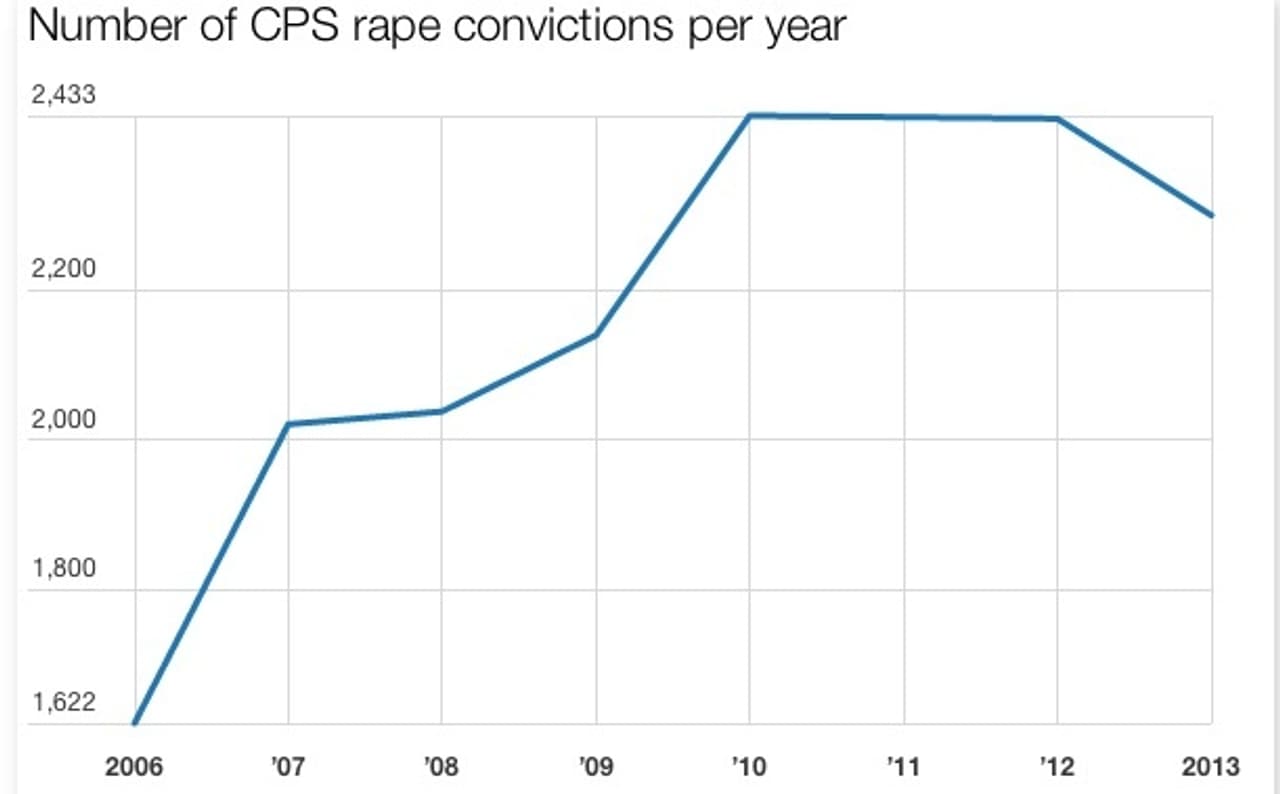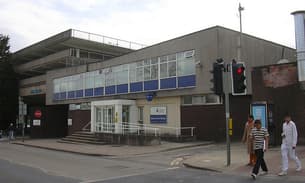
Are CPS performance measures to blame for fall in rape convictions?
When CPS rape conviction figures, which had been increasing since 2006, began to level off in 2010, nobody was too worried.
Three years later Keir Starmer, who was in charge of the CPS during this period (he left in November 2013) started to be concerned.
‘We initially thought that the numbers might be plateauing and would continue the upward trend,’ he says.
‘But then they started to go down.
‘And it is not due to rape offences dropping, I am certain about that.’
Related story: Rape convictions at four year low despite attempts to bring more cases to court
Rape convictions – and specifically the often-quoted statistic that only around 6% of police-recorded rapes end in a rape conviction (more on this later) – have been a focus of women’s anger for a decade.
Conviction figures should be improving. Considerable effort – and cash – has been expended on improving management of rape cases since 2010:
- 15 new units for collecting forensic evidence from victims have been set up in addition to the 45 already in place;
- 87 publicly-funded independent advisors are now on hand to help anyone who reports rape in their journey through the criminal justice system, up from 44 in 2010;
- Most CPS areas and several police forces have set up specialist units dedicated to sexual offences;
- The number of barristers on the CPS’ panel of rape specialists have soared;
And these factors are all on top of other CPS measures announced in 2010 to ‘strengthen the prosecution of rape‘.
Mr Starmer says it’s very hard to pinpoint why all this hasn’t translated into an increase in convictions – or indeed prosecutions, which also peaked in 2010 – let alone a decline.
‘It may be related to the decline in referrals from the police,’ he suggests.
Referrals of rape cases from the police to the CPS have declined drastically – in part due to police interpretations of CPS guidance – since 2011.
Related story: Met dismisses up to a third of rape allegations
Although as the current director of public prosecutions Alison Saunders revealed to the Bureau, the referral figures are unreliable.
Term ‘rape conviction rate’ dubbed unhelpful, redefined – and used to emphasise CPS success
Another explanation for the conviction figures falling may lie in the CPS’ focus on ‘rape conviction rates’.
Prior to 2010, this term was generally used in the context described above – that is, the percentage of rape offences that result in rape conviction.
In her 2010 review of rape, Baroness Stern criticised this use of the term, saying that the 6% figure was ‘taking over the debate’ to the detriment of victims and ‘extremely unhelpful’.
She noted that for other crimes ‘conviction rate’ was used to describe the percentage of all the cases brought to court that end with the defendant being convicted. Using this definition, the conviction rate for rape was higher than for other serious crimes: in practice someone could be charged with rape and a lesser offence, be found guilty of the lesser offence and then this be counted as a rape conviction.
Baroness Stern observed: ‘A senior politician told us, “The problem is getting out the message that the conviction rate is high once a case is accepted by the CPS”.’
Since then the CPS has not lost an opportunity to get that message out.
CPS emphasised increases in conviction rate as numbers of convictions fell
The majority of public messages from the CPS around rape in the last two years have emphasised conviction rates.
Last year – as rape prosecutions and convictions fell – the CPS put out press releases announcing ‘an all time high for the conviction rate in rape cases‘ and ‘a second year of record conviction rates for rape‘.
In its annual Violence Against Women and Girls report for 2013 the CPS highlighted three ‘top performing’ CPS regions on rape. Two had achieved significantly fewer rape convictions than in the previous year.
East Midlands achieved only 188 convictions in 2012/13 compared with 208 the previous year, while East of England had 18% fewer convictions.
Public confusion
These messages resulted in public confusion between numbers of convictions and conviction rates.
Several newspapers welcomed rises in numbers of rape convictions where in fact falls had occurred.
The Daily Express reported in 2013 that ‘the number of successful convictions of defendants charged with rape has continued to rise,’ when it had actually fallen.
And Bradford Telegraph and Argus quoted the local Rape Crisis centre welcoming ‘the increase in rape convictions’.
In fact, in Yorkshire & Humberside convictions fell by almost a fifth, from 251 convictions to 203 and it was the conviction rate that had risen.
Rate-based targets have created perverse incentives in the police
Police forces including the Metropolitan Police have now dropped targets based on the percentage of reported rapes resulting in a charge and instead performance is measured on actual numbers of cases charged.
This is because rate-based targets have been found to encourage ‘gaming’ – officers were dropping difficult cases in order to improve their performance.
It’s easy to see how CPS staff might similarly realise that fewer, more straightforward cases to manage would make improvements in conviction rates easier to achieve, and pass the message on to police that only the strongest cases are to be passed on.
Several police forces told the Bureau last year their rape referrals had decreased following discussions with the CPS about the extent of evidence needed before a case could be sent on.
Ms Saunders denies that a focus on conviction rates has lead to CPS pressure on police to refer fewer or stronger cases for charging.
She says that ‘assurance measures’ introduced in Janury 2011 to monitor handling of rape and other violent crimes against women include volumes of prosecutions and convictions as well as conviction rates.
But the categorisation of areas with declining volumes as ‘high performing’ does not support this assertion.
And can we be certain that Ms Saunders – or anyone else from CPS HQ – would know if staff in the regions were turning difficult cases away in order to be recognised as ‘high performing’?
Related story: Judges should help to tackle the ‘myths and stereotypes’ of rape cases says DPP
The assurance process included frequent intensive monitoring of rape cases in each CPS area, with ‘remedial action’ to be taken to ensure a consistent approach across the country.
Yet despite this process the CPS failed to notice – until after a public outcry about the decline in rape referrals from police – that there is very little consistency in prosecutors’ relationship with the police, leading to huge variations in how decisions to refer are made and counted.
The fact that the decline in referrals may be due in part to the CPS’s own charging guidance has apparently come as a surprise to many in the police and CPS, although a charity, Rights of Women, cottoned on to this and wrote about it two years ago.
It would be ironic if Baroness Stern’s thoughtful review had indirectly led to a decline in convictions.
Related story: Case study: ‘Type of underwear’ influenced CPS decision to drop rape case
But in attacking the use of the 6% conviction rate by victims’ campaigners she removed a useful weapon from a limited armory – an armory that is needed to challenge the highly pessimistic view on rape convictions quoted elsewhere in her report:
‘All those who spoke to us who worked in the criminal justice system felt that the number of cases which were taken to court and ended in a conviction could be increased, no one argued that the increase could be substantial.’






